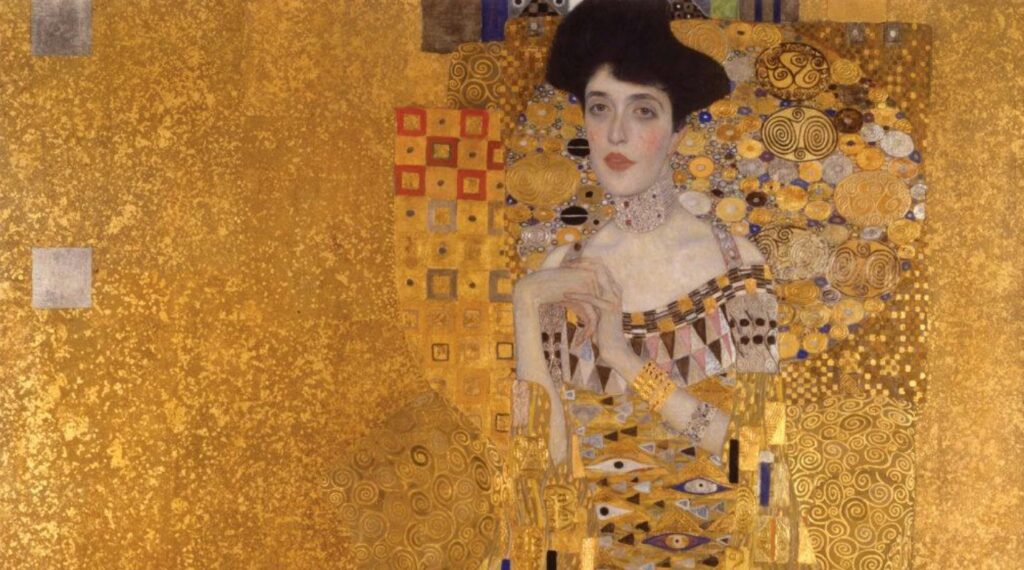Introduction: Maria Altmann’s Extraordinary Story
Maria Altmann’s tale isn’t your everyday David vs Goliath story, but rather, it’s a twisting, turning saga layered with history, drama, and the relentless pursuit of justice. It’s not just about an ornate painting by Gustav Klimt, “Portrait of Adele Bloch-Bauer I”, more commonly known as the “Woman in Gold.” It’s about a legacy reclaimed, a wrong righted, and a chapter in history forever altered.


The Battle Against the Austrian Government
Picture this: Altmann, a small woman with an immense spirit, found herself at the center of a dispute that would extend all the way to the U.S. Supreme Court. Her opponent? A government. Not just any government, mind you, but the Austrian government, which had claimed her family’s priceless art treasures as its own.
The Stolen Masterpiece: “Woman in Gold”
At the heart of the story is the radiant “Woman in Gold,” a golden portrait of Maria’s beloved aunt, Adele Bloch-Bauer. This painting was stolen during the chaos of World War II by Nazis. It was more than just a painting to Maria. It was a part of her heritage, her past, a token of her family’s rich legacy that was unjustly taken away. And she was determined to get it back.
Gustav Klimt: The Artist and His Muse
The painting is of Adele, the muse, who is swathed in an opulent golden dress adorned with intricate, Byzantine ad Egyptian-inspired patterns, resonating with the affluent lifestyle of the Viennese bourgeoisie. Her enigmatic expression, paired with her regal posture, exudes a mysterious allure. The backdrop is a glittering tapestry of shimmering gold and silver embellishments. Klimt’s exquisite detailing, along with his distinctive use of gold leaf, immortalizes Adele as a golden icon. It is a breathtaking piece of art.
The Legal Labyrinth
The road to reclaiming the masterpiece was a complex labyrinth of legal twists and turns. When she initially approached Austrian officials about her family’s stolen art, they appeared cooperative, even amicable. But when it came to concrete action, the government refused to acknowledge Maria’s rightful ownership. They didn’t respond to her letters, rejected negotiations, and even disputed the Holocaust underpinnings of the case. That was when Maria realized that she wasn’t merely wrestling with the Austrian government over an art dispute, but she was challenging a deeply entrenched system of denial and avoidance.
But Maria wasn’t one to back down. With an indomitable spirit, she pursued her case, despite the seemingly insurmountable challenges. The brilliant attorney E. Randol Schoenberg helped her with the help of the persistent journalist Hubertus Czernin, who unearthed pivotal documents to strengthen Maria’s claim.
The Fight for Justice
The fight was arduous. The Austrian government challenged Maria’s claims, asserting their right based on an old will left by Adele herself, wanting her art to remain in Austria. Yet, after much scrutiny, persistence, and probably countless cups of strong coffee, Maria and her legal team managed to convince the Austrian arbitration court that her uncle, Ferdinand Bloch-Bauer, was the rightful owner of the paintings, and he had indeed left them to his heirs.
In a dramatic and profound conclusion to the saga, the Austrian court ruled in Maria’s favor, finally acknowledging the truth. Maria sold the illustrious “Woman in Gold” to Ronald Lauder for a cool $135 million, and the painting found a new home at the Neue Galerie in New York, where it continues to enchant visitors with its allure.
The Celebrity Twist: Oprah Winfrey’s Involvement
As if that wasn’t enough, there’s more to the story. There’s a celebrity twist involving none other than Oprah Winfrey. In 2006, Oprah bought the second portrait of Adele, “Portrait of Adele Bloch-Bauer II,” for a jaw-dropping $87.9 million. This treasure was part of the art collection Maria repossessed from Austria. Ten years later, Oprah sold the painting for a whopping $150 million to an unknown Chinese collector.
Conclusion: A Tale of Tenacity, Justice, and the Power of Art
This saga is so much more than a legal battle. It’s a tale of tenacity, justice, and the everlasting power of art. Maria Altmann, an everyday woman, faced a daunting challenge and emerged victorious. She stood up to a government, recovered her family’s stolen treasures, and threw light on a hidden facet of Austria’s history.
Here’s to Maria Altmann, the unsung hero who defied the odds and changed the world of art restitution forever. So, the next time you marvel at a piece of art in a museum, remember, each stroke of paint has a backstory, sometimes as fascinating as the masterpiece itself.
📈😲Additional Fun Facts
71% Increase
Oprah Winfrey bought Gustav Klimt‘s Portrait of Adele Bloch-Bauer II in 2006 for $87.9 Million at Christie’s auction house and then sold the painting to a Chinese collector in 2016 for $150 Million, a whopping 71% increase in value of the painting.
Helen Mirren
Played Maria Altmann in the 2015 Hollywood film titled “Woman in Gold.”
14 Children
There’s talk that hGustav Klimt had romantic relationships with all the women he painted and that he fathered a sizeable brood of 14 kids out of wedlock over his life span. Klimt himself seemed to shrug off these whispers, focusing instead on his art. His statement says it all: “Whoever wants to know something about me, as an artist, which alone is significant, should look attentively at my pictures and there seek to recognise what I am and what I want.” He painted many women.

